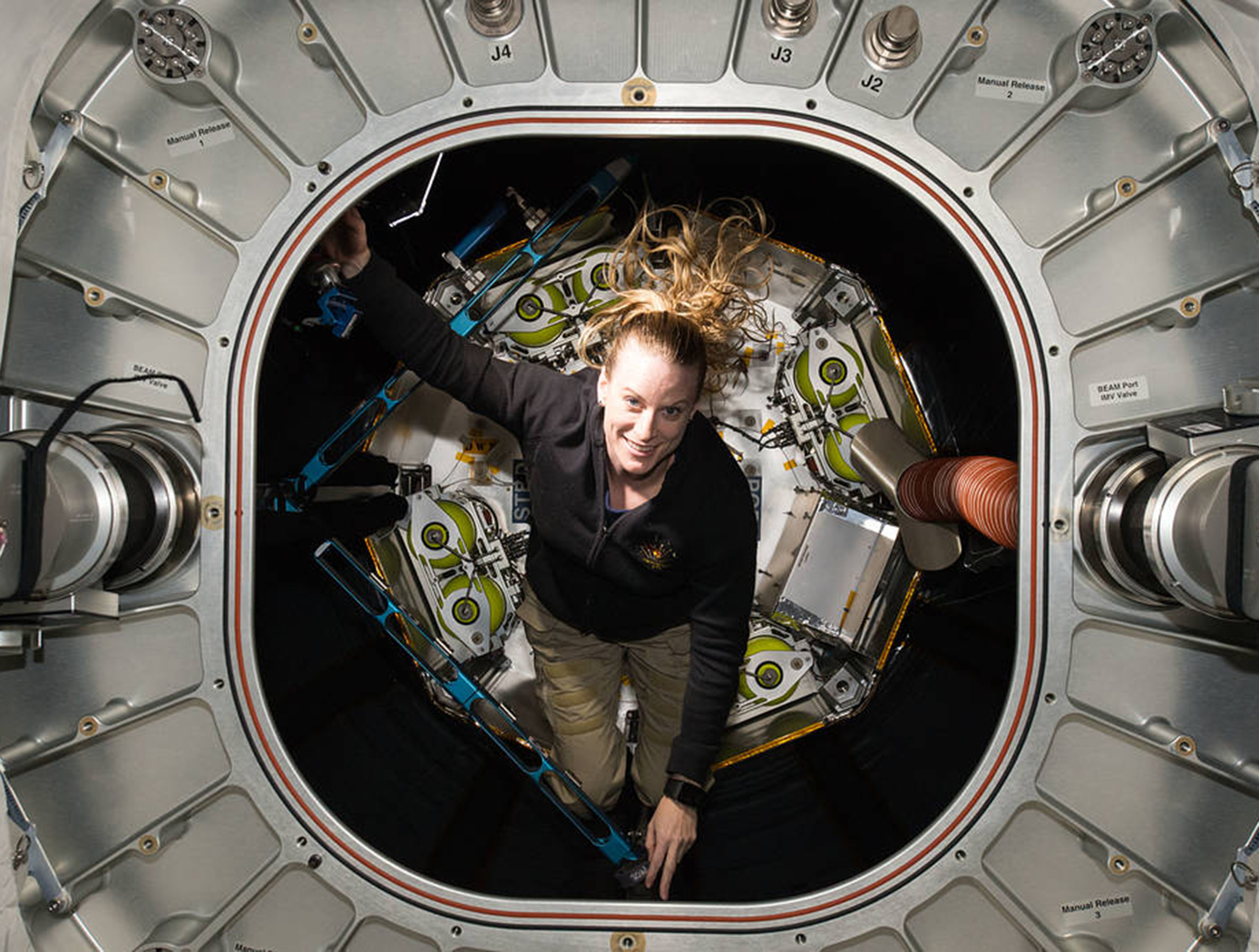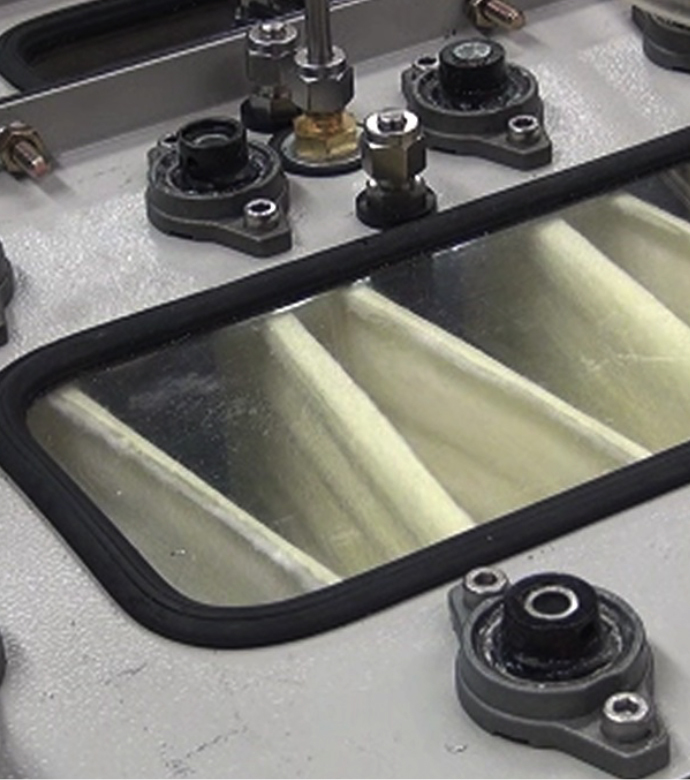Multi-Stage Filtration System
environment
Multi-Stage Filtration System (LEW-TOPS-93)
Particle impactor and scroll filter operate in high-temperature, extreme environments
Overview
Innovators at NASA's Glenn Research Center have developed a unique multi-stage filtration system to collect a wide range of particle sizes with minimal filter changes. This breakthrough capability keeps high-efficiency media and devices from becoming overloaded with larger particles. Glenn's system uses an impactor filter to capture larger particle matter through inertial separation and impaction methods on collection surfaces. After becoming heavily loaded, this filter can be cleaned automatically through a unique feed system, thereby reducing maintenance costs. In this way, the device provides a pre-filter stage that protects the more critical stages of the filter system, thereby extending the life of high-efficiency particulate arresting (HEPA) filter systems that are designed to capture fine and ultrafine particles. In an effort to reduce maintenance even further, the fine-particle filter media is provided in a scroll mechanism that is advanced to successive clean sections as needed. Highly sensitive filtration systems can be challenging to maintain and protect, so Glenn's system, which provides time and power savings offers great potential for commercial development.
The Technology
While HEPA filter elements can last for years without intervention, pre-filtering systems that remove larger particles before they reach the HEPA filter need to be treated (most often by cleaning or replacement) as often as once a week. These treatments can be resource-intensive and expensive, especially in extreme environments. Glenn's innovative system combines a pre-filtration impactor and a scroll filter that reduces the need to replace the more sensitive or expensive filters, extending the system's working life. The system uses an endless belt system to provide the impaction surface. A thin layer of low-toxicity grease is applied to the impaction surface to increase particle adhesion. A high flow turning angle near the impaction surface causes relatively large particles to impact and stick to the surface while smaller particles stay within the air flow. When the surface is covered with particles - or if a layer of particles has grown to a thickness that impairs adhesion - the surface is regenerated. The band is rotated so that the loaded surface passes by a scrapper, removing the layer of particles and a clean segment of the band revolves to become the new impaction surface.
A further innovation is the scroll filter which allows the filtration media to be rotated out of the airflow when fully loaded, providing multiple changes of the filter through a motorized scrolling or indexing mechanism. When nearly fully loaded with dust particles, the exposed media is mechanically rolled up on one side of the filter to both contain and compactly store the dust. The spools that hold the clean and spent filter media are mounted on roller bearings to facilitate the scrolling operation and reduce motor power requirements. Nearly any grade of filter media can be used to meet the desired filtration specification. Additional media rolls can be added after the original roll is spent to further increase filter life.


Benefits
- Cost-saving: Provides operational longevity over state-of-the-art filter systems
- Low-maintenance: Offers regeneration capability, which saves on valuable resources such as crew time, waste disposal, and power usage
- Robust: Works in closed-system, extreme temperature, and high-pressure environments
Applications
- HEPA filters
- Fluid and gas dynamic research for flow imaging
- Air and gas systems
- Microgravity environments
- Fluid mechanics
- Commercial aircraft
- Submarines
- Remote instruments
Technology Details
environment
LEW-TOPS-93
LEW-18837-1
LEW-18837-2
LEW-18837-3
Similar Results

Filtering Molecules with Nanotube Technology
This water filtration innovation is an acoustically driven molecular sieve embedded with small-diameter carbon nanotubes. First, water enters the device and contacts the filter matrix, which can be made of polymer, ceramic, or metallic compounds. Carbon nanotubes within the matrix allow only water molecules to pass through, leaving behind any larger molecules and contaminants. The unique aspect of the technology is its use of acoustics to help drive water through the filter.
An oscillator circuit attached to the filter matrix propagates acoustic vibration, further causing water molecules to de-bond and move through the filter. This use of acoustics also eliminates dependence on gravity (and thus filter orientation) to move water through the device. When water exiting the system diminishes to a pre-determined set point, a cleaning cycle is triggered to clear the sediment from the inlet of the filter, reestablishing the standard system flow rate. Unlike other filtration systems, flushing of the filter system is not required. The combination of acoustics and small-diameter carbon nanotubes in this innovation make it an effective and efficient means of producing contaminant-free, clean water.

Particle Contamination Mitigation Methods
The following methods can be used individually or in combination to generate superhydrophobic surfaces:
Synthesis of novel copolyimide oxetanes with unique surface properties
The technology is the synthesis of a polyimide coating or film with a modified surface chemistry shown in Figure 1. A minor amount of an oxetane reactant containing fluorine is added to the polyimide, and the oxetane preferentially migrates to the surface, enabling relatively high concentrations of fluorine at the surface, without compromising the functional performance of the bulk of the polymide coating/film.
The copolymers exhibit mitigation of particle adhesion and fouling from exposure to various particulate and biological contaminants and exhibit reduced surface energy and increased surface fluorine content at extremely low oxetane loadings relative to the imide matrix (see Figure 2). Additionally, the short fluorinated carbon chains do not bioaccumulate, reducing the environmental impact of these materials.
Modifying surface energy via laser ablative surface patterning
This method uses a laser to create nanoscale patterns in the surface of a material to increase the hydrophobicity of the surface (see Figure 2). The benefits of hydrophobic surfaces include decreases in friction and increases in self-cleaning properties. This is an advantageous method of surface modification because it is fast and single-step, promises to be scalable, requires no chemicals, could be applied to a variety of materials, and does not require a planar surface for patterning.
Corkscrew Filter Extracts Liquid From Air Charge
In the event of a fire aboard the Orion Spacecraft, the Portable Fire Extinguisher (PFE) can introduce up to three pounds of water into the cabin to extinguish a fire. A filter was needed to work in conjunction with the Orion Fire Safety System (OFSS) to filter water out of the cabin atmosphere after dispersal from the PFE. Airflow introduced to the smoke filter of the OFSS must be dry and free of large particulates for the sorbent material to effectively extract smoke generated by a fire.
These moisture and particulate concerns prompted a re-design of the original filter, especially a filter that could be tested in Earth’s gravity and yielding results that would transfer to a microgravity environment. The newly designed filter uses a multi-phase flow separation method that allows the airflow to develop fully in a helical flow path. This flow path resides within a wicking material used to separate the liquid from the gas (air) while also trapping particulate matter.
Helical flow paths implemented in the filter impart a centrifugal force upon the incoming gas/liquid mixture that develops an asymmetric liquid film on the inner contour of the helix. Upon active airflow, the larger water droplets are inertially forced into the inner contour flow path wall. The flow path walls are made from a wicking material, and all liquid film and liquid droplets that are inertially deposited onto the walls are adsorbed into the filter material. The resulting output flow from the filter is 100% gas.
The Corkscrew Filter has a technology readiness level (TRL) of 5 (component and/or breadboard validation in relevant environment) and is now available for patent licensing. Please note that NASA does not manufacture products itself for commercial sale.

Low-Power Charged Particle Detector
Conventional scintillation radiation detectors make use of materials that emit light when hit by ionizing radiation. These large, bulky scintillators range anywhere from 6 inches to 6 feet in size. They are attached to glass photomultiplier tubes (PMTs), which are fragile, require high voltages, and are extremely sensitive to temperature changes. Conventional detectors also include a wave shifter (a material with a dopant to re-emit the scintillator light to match the sensitivity of the PMT or photodiode) which reduces efficiency and introduces unwanted weight and bulk.
Glenn's particle counter overcomes these challenges. A prototype was constructed from off-the-shelf components, and features a small scintillator (less than six inches long) and a low-voltage, UV-sensitive, wide-bandgap photodiode as the detector. Careful matching of the properties of the light emitted from the scintillator, and tailoring the sensitivity of the photodiode eliminates the need for a PMT and a wave shifter, not only saving space, weight, and power but also eliminating potential failure modes. By using wide-bandgap detectors, it can operate in changing temperature, vibration, pressure, and gravity conditions without need for a temperature compensation system. Built from solid-state components, Glenn's device is compact and robust.

Debris-Tolerant Valve
NASA's Debris-Tolerant Valve is designed for use in machines/environments with a large quantity of airborne dust or other contaminants. Valves subjected to airborne contaminants tend to have limited lifetime due to damaged seals, bearings, and other internal components. The Debris-Tolerant Valve design addresses this problem with four core improvements over existing commercial valves that are typically used in dusty or debris-laden processes: (1) a new cylinder design that substantially decreases dust collection within the valve; (2) a rotational valve design that minimizes grinding and packing experienced by the standard ball valve; (3) the use of elastomeric seals rather than the Teflon-based seals used in existing valves which are prone to scratching and subsequent leakage; and (4) a bleed port for fluid intake that allows pressure to build slowly in the valve and eliminates the stirring of dust commonly caused by rapid inflow of air in existing valves.
The operational lifetime of NASA's Debris-Tolerant Valve exceeds the lifetime of a standard commercial valve and the existing selector valve used on the ISS by 12X and 6X, respectively. NASA's valve design has fewer parts than existing valves and could be disassembled without tools, enabling easier servicing and maintenance. The Debris-Tolerant Valve is only about one-seventh (1/7) the cost of the existing ISS selector valve.



